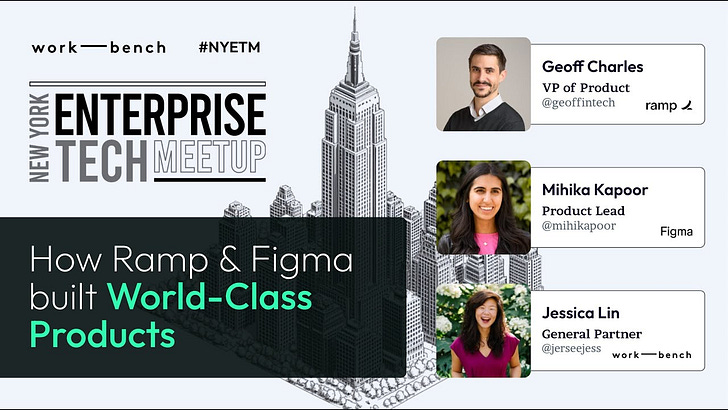Ramp & Figma on How to Build World-Class Products
"Feature Factory" isn't always bad; sometimes you must simply build what the customer needs with agility.
Product strategy & vision
Have a long-term vision, but a short-term (6-month) roadmap.
Don't waste time prioritizing things you can just do sequentially; the time spent debating is time not spent building.
If something is truly important, question why it's two years away and not being built now.
For B2B, prioritize talking to customers over analyzing data, which is often a lagging indicator.
Distinguish between three separate documents:
Vision: The world you want to see.
Strategy: Why you believe your vision and roadmap will win.
Roadmap: How you will get there in the short term.
Shipping with velocity & quality
"Feature Factory" isn't always bad; sometimes you must simply build what the customer needs with agility.
Close the feedback loop instantly: get feedback from a customer, build it overnight, and demo the fix the next day.
Use design systems to maintain consistency and accelerate developer productivity.
Maintain high quality by dogfooding products internally for months before a public launch.
Create a culture where it's safe to share early, unpolished work internally to get collective feedback.
Team & org design
Structure teams by outcomes and personas (e.g., an "accounting persona" team focused on closing the books).
Avoid horizontal teams where possible to reduce prioritization politics and bottlenecks.
Embrace the philosophy: "The train is moving, you're either waving or you're on the train. But you're not on the train tracks".
To stay humbled and close to users, have the entire team, including PMs and engineers, do customer support one day a month.
Driving bottom-up innovation
Figma Slides started as a hackathon project after leadership repeatedly said no.
Use hackathons and prototypes to make an idea bigger than yourself and get company-wide buy-in.
Being out of the leadership limelight can be a blessing, allowing a team to focus on execution.
Launching a second product is hard; the sales team won't care about it until it's a proven moneymaker.
Aligning product & go-to-market
To win, you need all three: product, people, and distribution. Two out of three is a fail.
The goal is not "PLG vs. Sales," but how the product can make the sales team more efficient.
PMs and engineers should sit in on sales calls to hear customer pain firsthand, not through a summary.
Find your best salesperson and make them your best friend; their feedback is the most valuable because they know how to close deals.
Hard-won advice for builders
The biggest mistakes are always around hiring. Be incredibly specific about a role's goals before you hire for it, especially a "Head of" role.
When talking to users, go in with an opinionated "A-minus" idea. A strong, even if wrong, starting point elicits a much better reaction than a blank slate.
Identify your personal superpower (e.g., energy, technical skill) and lean into it.
As a leader, your job is to see the superpowers in your team members and put them in roles where they can shine.
notes from:



